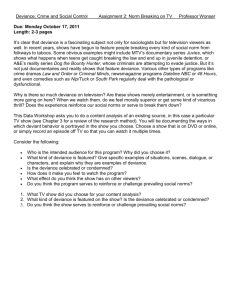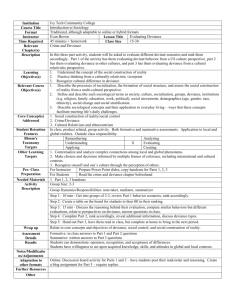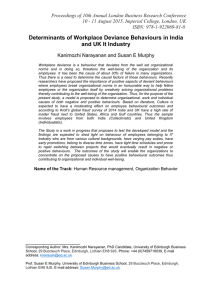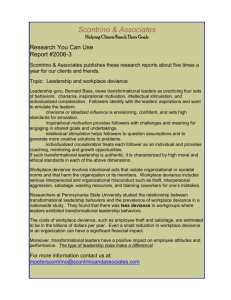discovering-pd-slides-deck - Canadian Positive Deviance
advertisement
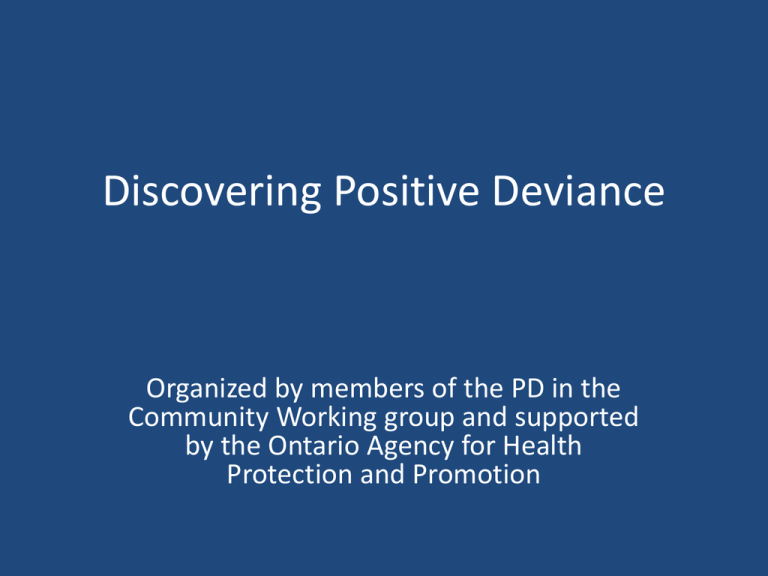
Discovering Positive Deviance Organized by members of the PD in the Community Working group and supported by the Ontario Agency for Health Protection and Promotion Why focus on a behaviour change approach? • Current “top down” approaches have had limited success • Traditional “best practice” approach has been disappointing • We need to acknowledge that we are human! Power in Relationships Not Fixing the Parts, the System, or the People Performance as an emergent property… arising from local interactions and patterns of relating on the front line. Sharing best practices • Solutions imported from external sources results in “social immune response” in the same way that our body triggers an immune defense response The Premise Of Positive Deviance No matter how seemingly intractable a problem, in every community there are individuals whose uncommon practices/behaviours enable them to find better solutions to problems than their neighbours who have access to the same resources. TAKE Think about someone you know who you suspect might be a positive deviant… What are they doing? What makes you recognize their behaviour as unusual or different? In any group… Increasing performance Malnutrition in Vietnam Children PD and MRSA • US pilot project • Implementation of PD followed by 20 month follow up period • No attempt to decolonize patients • 26-62% reduction in MRSA clinical infections • 1 site had an 80% drop in MRSA infections SHEA 2009 This is about… • Creating sustainable change • Helping culture to shift • Indentifying existing and/or uncommon practices • Developing new behaviours to overcome barriers Acting your way into a new way of thinking Time for an attitude adjustment… Who have the knowledge? ≈ The “Awareness” Iceberg 4% Problems known to top managers 9% Problems known to middle managers 74% 100% This internationally acclaimed study conducted by Sidney Yoshida, was initially presented at the International Quality Symposium, Mexico city, 1989. It indicated how management's failure to understand its processes and practices from the perspective of its customers, suppressed the company's profits by as much as 40%. Problems known to supervisors Problems known to front line managers 100% 74% 9% 4% TAKE Consider your work today… Who holds the power? Who are considered the experts? What would it take to flip the iceberg? Positive Deviance Discern Disseminate Design Discover Define Determine How does it work? • Invite those who are interested • Front-line staff must be there (the “Gurus”) • Create conditions for people to discover and adopt their own solutions • Identify and analyze the positive deviants • Create ways to spread peer to peer • Track and publish results Who is included? Everybody who touches the problem – Get the right people around the table – Who isn’t here? – “nothing about me without me” PD Tools • • • • • • Kick offs Improvisation Sharing Stories Discovery and Action Dialogues Social Network Analysis Ethnographic mapping Tracking Impact • Define the things you will measure together • Data potluck – A Menu of Measures you generate to make sense of what is happening, encourage people to keep going, generate a sense of accomplishment, share stories and impact. Social Proof Social Network Analysis • Reveals communicative patterns of complex groups and teams – Identifies the strength and frequency of connections (e.g., with whom and how often do you communicate about the problem you are working on) – Can describe current network in general & specific clusters of common interest in particular The power of storytelling • One death is a tragedy; one million is a statistic. • Stories can capture the complexity of the situation. Power in Relationships Not Fixing the Parts, the System, or the People Performance as an emergent property… arising from local interactions and patterns of relating on the front line. Learn from the people Plan with the people Begin with what they have Build on what they know. Of the best leaders When the task is accomplished The people all remark We have done it ourselves Lao-Tzu’s Tao Te Ching (6th Century BCE)


